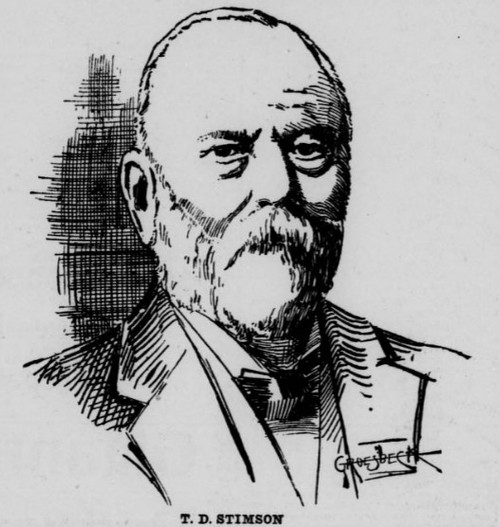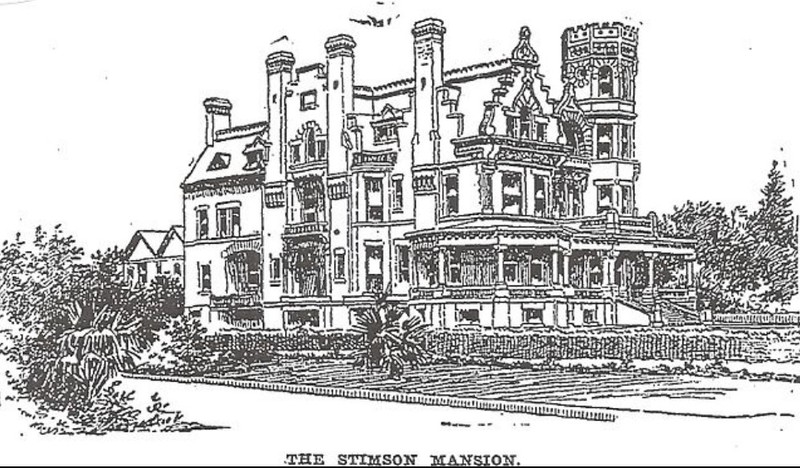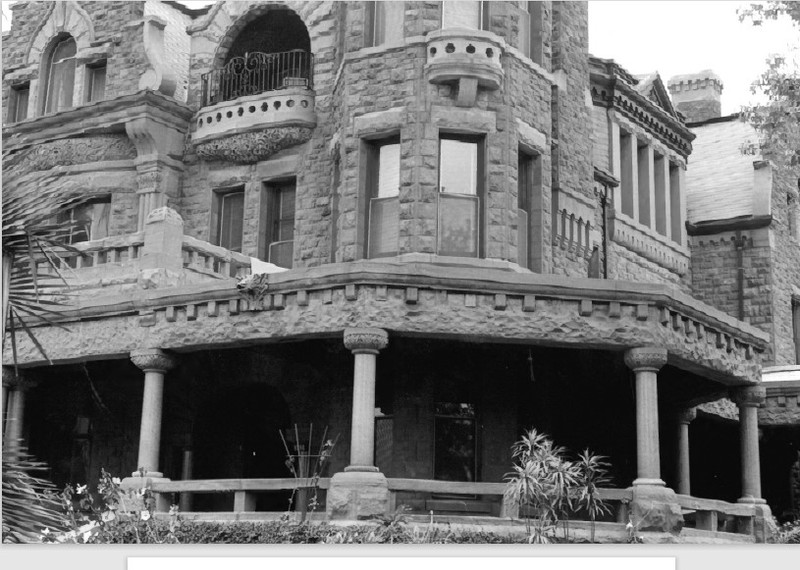Stimson House
Introduction
Text-to-speech Audio
The stone house with a tower was constructed in 1891 in the Richardson Romanesque style. The mansion was initially the retirement home of millionaire lumber baron, Thomas D. Stimson. A blackmailer threatened Stimson and attempted to blow up his house in 1896, and the incident resulted in a small crater in the side yard, as well as a prison term for the blackmailer. Stimson died in the home in 1898 at age 70. The Stimson House has also been the home of a brewer, a fraternity house (U.S.C. is nearby), a convent, and student housing for St. Mary's College. In 1978, the Stimson House was listed on the National Register of Historic Places for its architectural significance. It is the only remaining mansion from the street once called "Millionaire's Row." The house was last sold in 2019 and is not open to the public.
Images
2008 view of front of Stimson House (Los Angeles)

Sketch of Thomas D. Stimson by Groesbeck in his 1898 newspaper obituary (The Herald)

Sketch of the Stimson House from 1896 newspaper story on the blackmail plot (Los Angeles Times, Feb. 7th, 1896, p. 10))

Northeast corner Stimson House with wraparound porch & tower base in 1977 photo (Tom Sitten for NRHP)

Stimson House (green arrow) with brick carriage house in backyard of house on 1894 Sanborn map (Vol. 3 p. 105)

Backstory and Context
Text-to-speech Audio
Thomas Douglas Stimson had a humble beginning in French Mills, Canada in 1828. After his mother died, the family moved to New York City when Thomas was 14 years old. He later became a businessman in Marquette, Michigan with a general store and eventually went into the lumber business. He rose from an employee to having his own lumber company by investing his savings. He managed to buy timberland in Michigan at a good price and became very successful in a short time. He moved to Chicago in 1877 where he became a leading businessman. In 1890, Stimson moved once again, to Los Angeles, where he invested heavily in real estate. A year later, he had a magnificent mansion built of stone for his family on Figueroa St. Stimson was associated with Citizens Bank and also served as Vice President of the L.A. Chamber of Commerce.
The imposing, fortress-like stone house was designed in Richardsonian Romanesque style, a popular style in Chicago for homes of the wealthy. The thirty-room mansion featured a four-story Gothic crenellated tower, stepped gables, and a basement with a wine cellar. The design was by a local architect, Carroll Herkimer Brown (1863-1920). Brown also designed a commercial block for Stimson, built in 1893 at Third and Spring Streets in L.A., named the Stimson Block; the six-story office building was demolished in the 1960s. The red stones for the house were sourced in New Mexico. Given the source of Stimson's wealth, the interior featured many types of wood paneling and flooring; the inspiration was photos of the sumptuous interior of Stimson's previous mansion in Chicago.
Mr. Stimson's House became part of a scheme to blackmail its millionaire owner. He was repeatedly visited by a private detective he was acquainted with, Harry Coyne, who claimed that three criminals were planning to harm Stimson or his home. Coyne offered to help Stimson by luring the blackmailers to the mansion and killing the perpetrators (so they couldn't retaliate against Coyne) for a fee. A stick of dynamite was placed by the south front foundation near Stimson's bedroom one evening in early 1896 and lit, but the stone fortress stood firm. The force blew a hole into the nearby ground about three feet deep. Neighbors saw a man flee from the scene but were unable to catch him. Coyne then offered to guard the Stimson House, for a fee, since the criminals had eleven more sticks of dynamite ready to use. After Stimson accused Coyne of being too familiar with the whole affair, a trial was held, and Coyne was convicted of the crime. He was sentenced to five years in prison.
"T.D." Stimson died of heart failure at age 70 at his "palatial Figueroa Street residence" on January 31st, 1898, after a brief illness. At his bedside were his wife Achsah, son Willard, daughter Mrs. J.J. Fay, and son-in-law. Three other sons lived in Seattle and Brooklyn. The funeral was held at the house, with the casket in the center of the drawing room; sixty carriages of mourners followed the funeral to Rosedale Cemetery. His widow Achsah J. (Spencer) lived in the mansion, on what had become "Millionaire Row," until her death in 1904. She had been instrumental in efforts to establish an industrial school that started as a kindergarten on Lafayette and Jackson Streets.
The house was next the home of a civil engineer, Alfred Solano. A brewer, Edward R. Maier, purchased the Stimson House in 1918 and it remained as the family homie until 1940. A fraternity from nearby University of Southern California (U.S.C) purchased the mansion and it became the Pi Kappa Alpha house. A woman who lived nearby the noisy frat house remembered watching the Stimson House being built in 1891 when she was a child. Carrie Estelle Doheny, the wealthy widow of an oilman (Edward L. Doheny). purchased the Stimson House from the frat by offering much more than they had paid, and her peace and quiet returned. To ensure the neighborhood tranquility, Mrs. Doheny deeded the property to nuns to use as a convent. The Sisters of St. Joseph of Carondelet resided in the mansion until 1969. From 1969 to 1993, the Stimson House became student housing for Mount St. Mary's College. The nuns moved back in 1993 but had to vacate after the 1994 Northridge earthquake caused major structural damage. Millions were spent in repairs and renovations in the 1990s. The Stimson House was last sold in 2019 and contains over 20,000 square feet.
Sources
Anonymous. "Industrial School: Meeting Held Yesterday at Mrs. T. D. Stimson's Residence." The Herald (Los Angeles) March 5th, 1896. 5-5.
Anonymous. "Coyne was out for Coin: Held to Answer in the Stimson Explosion Affair." Los Angeles Herald (Los Angeles) February 29th, 1896. 4-4.
Anonymous. "A Heavy Loss: The Sudden Death of T. D. Stimson." The Herald (Los Angeles) February 1st, 1898. 5-5.
Anonymous. "Giant Powder was Used." Los Angeles Herald (Los Angeles) February 7th, 1896. 4-4.
Anonymous. "Laid to Rest: Funeral Services over T. D. Stimson's Remains." Los Angeles Herald (Los Angeles) February 4th, 1898. 10-10.
Bariscale, Floyd B. No. 212 - Stimson Residence, Big Orange Landmarks. February 4th, 2009. Accessed June 5th, 2023. http://bigorangelandmarks.blogspot.com/2009/02/no-212-stimson-residence.html.
Michelson, Alan. Brown, Carroll H., Architect (Practice), Pacific Coast Architecture Database (PCAD). January 1st, 2023. Accessed June 5th, 2023. https://pcad.lib.washington.edu/firm/1239/.
Sitten, Tom. Hatheway, Roger. NRHP nomination of Stimson House, Los Angeles, California. National Register. Washington, DC. National Park Service, 1977.
https://en.wikipedia.org/wiki/Stimson_House#/media/File:Stimson_House,_Los_Angeles.JPG
The Herald (Los Angeles). February 1st, 1898, p. 5
https://en.wikipedia.org/wiki/Stimson_House#/media/File:Stimson_Mansion,_1896.jpg
National Park Service (NPS): https://npgallery.nps.gov/AssetDetail/NRIS/78000690
Library of Congress (LOC): https://www.loc.gov/item/sanborn00656_005/
